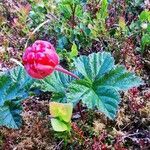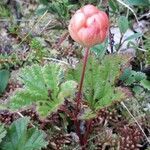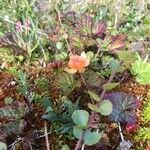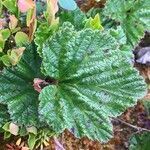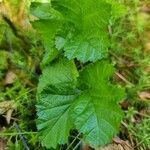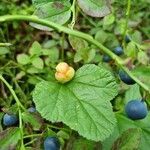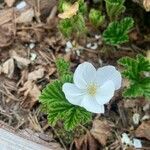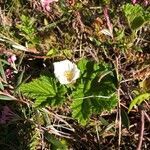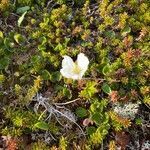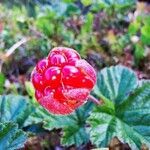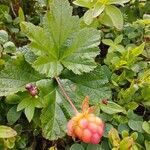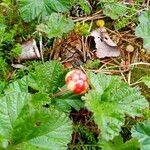Herbs perennial, dwarf, 5–30 cm tall, dioecious, with long branched creeping rhizomes. Stems annual, somewhat woody, simple, erect, 30 cm tall, with few squamous leaves, pubescent, with intermixed sparse, short glandular hairs. Leaves simple; petiole 3–6(–9) cm, pubescent or with sparse, short glandular hairs when young; stipules free, leaflike, brownish, oblong, 5–10 × 4–7 mm, pubescent, with sparse, intermixed short glandular hairs when young, glabrescent; cauline leaf blade reniform or orbicular, 4–9 cm in diam., abaxially pubescent, ± with intermixed short glandular hairs when young, adaxially subglabrous or slightly pilose, base cordate, margin 5–7-lobed; lobes obtuse, with uneven coarse sharp serrations. Inflorescences terminal, 1-flowered. Pedicel 3.5–6 cm, pubescent, with sparse, intermixed short glandular hairs. Flowers unisexual, 2–3 cm in diam., usually staminate larger than pistillate, to 3 cm in diam. Calyx abaxially pubescent, sometimes with intermixed short glandular hairs; tube 1.5–2 mm; sepals erect, spreading, 4 or 5, oblong, 0.8–1.2 cm × 4–6 mm, apex obtuse or acute. Petals 4 or 5, white, obovate, 1.4–1.8 cm × 7–10 mm, apex retuse. Stamens shorter than petals; filaments long, linear, basally somewhat broadened. Pistils abortive in staminate flowers; in pistillate flowers ca. 20; styles linear, long, but stamens not developed or without anthers in pistillate flowers. Aggregate fruit orange-red or becoming yellowish brown, subglobose, ca. 1 cm in diam., glabrous; pyrenes smooth or slightly rugulose. Fl. May–Jul, fr. Aug–Sep. 2n = 56.
More
Herbs, (0.5–)1–2.5(–3) dm, unarmed. Stems ?from rhizomes?, erect, ?rarely woody basally?, sparsely hairy, sparsely stipitate-glandular distally, not pruinose. Leaves deciduous, simple; stipules broadly ovate to oblong, 3–6 mm; blade reniform or orbiculate, 2.5–6 × (3–)5–8(–12) cm, base cordate, 3–7-lobed, lobe apices rounded, margins finely doubly serrate or dentate, abaxial surfaces sparsely hairy, sparsely to moderately stipitate-glandular along veins. Inflorescences 1-flowered. Pedicels pubescent, sparsely to densely short-to long-stipitate-glandular. Flowers unisexual; petals white, obovate, (8–)10–15(–18) mm; filaments filiform; ovaries glabrous, ?styles filiform, glabrous?. Fruits golden yellow to orange or reddish, globose, 1.2–1.5 cm; drupelets (5–)10–20, moderately coherent, separating from torus. 2n = 56.
Stems arising 1–3 dm from a creeping rhizome, essentially herbaceous, erect, unbranched, often flexuous, unarmed, the lowest nodes bearing stipules only; lvs commonly 2 or 3, long-petioled, simple, rotund to reniform in outline, the largest 4–9 cm wide, shallowly 5–7-lobed, serrate; fls solitary, terminal, long-peduncled, white, 2–3 cm wide, unisexual; sep becoming reddish; fr edible, orange to red, 1.5–2 cm thick, quickly deciduous from the dry receptacle; 2n=56. Bogs and wet mt. slopes; circumboreal, extending s. to N.B., Me., and N.H. June, July.
A creeping herb. It keeps growing from year to year. It grows 8-25 cm high. Young shoots arise from the rhizome or thin creeping rootstock. The leaves are 5-8 cm across. Plants are separately male and female. The flowers occur singly. The flowers are white and 4 cm across. There are often only 4 petals. The fruit are reddish-orange to yellow. They are edible.
Bogs, muskeg, wet meadows, mossy woods, boreal forests, peaty tundra, lichen peat polygons, exposed sandy areas, lakesides, gravelly stream beds and rock outcrops, avoiding shade and calcareous soils; at elevations up to 1,300 metres.
More
It is a cold temperate plant. It can grow in cold climates including the Arctic circle. It grows on acidic bog and peat tundras. It grows in swamps. In China it is in the northern provinces. It suits plant hardiness zones 2-5.
Can be grown by cuttings or seedlings. Seeds needs stratification.
